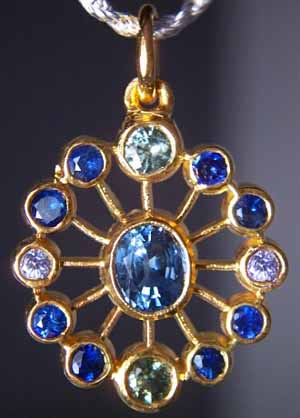

An amulet, also known as a good luck charm or phylactery, is an object believed to confer protection or luck to its possessor.
An amulet can be any object but its most important characteristic is its alleged power to protect its owner from danger or harm and create luck. Amulets may incorporate gems with specific significance or engravings, statues, coins, drawings, pendants, rings, bells, etc.
Depending on the metal and stones in an amulet - and how they interact - an amulet can display powers - but that is about science not pseudoscience.
As with crystals - people are drawn to certain amulets based on design - as if the ambulate itself was drawing them in, connecting with something on a subconscious level in that moment.
Amulets seem to attract their owners much like crystals do based on a person's frequency signature or matrix and that of the amulet.
Amulets made from meteors and other objects from outer space can exhibit unexplained abilities and powers, but again it is about science, not pseudoscience.
The use of amulets goes back to the beginning of time. They are found and depicted in all ancient and modern-day civilizations.
The word "amulet" comes from the Latin amuletum. The earliest extant use of the term is in Pliny's "Natural History", meaning "an object that protects a person from trouble".
Amulets are sometimes confused with pendants, small aesthetic objects that hang from necklaces. Any given pendant may indeed be an amulet but so may any other object that purportedly protects its holder from danger.
Amulets are different from talismans as a talisman is believed to bring luck or some other benefit, though it can offer protection as well.
Today amulets can be found among people of every nation and social status based on superstitions.. They can be displayed in jewelry, artisan fairs, museums, shops, homes, vehicles, just about anywhere.
Amulets may work briefly then seem to stop for no apparent reason as if they're 'battery' died. The lesson - don't give power to inanimate objects.
Amulets and talismans vary considerably according to their time and place of origin. In many societies, religious objects serve as amulets. A religious amulet might be the figure of a certain god or simply some symbol representing the deity such as the cross for Christians or the "eye of Horus" for the ancient Egyptians.
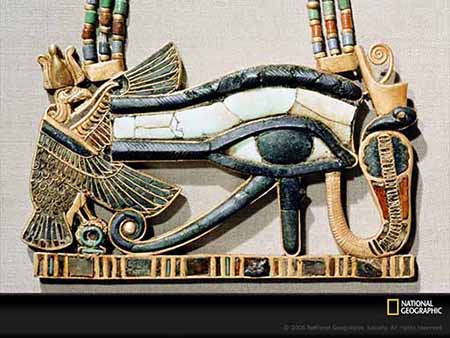
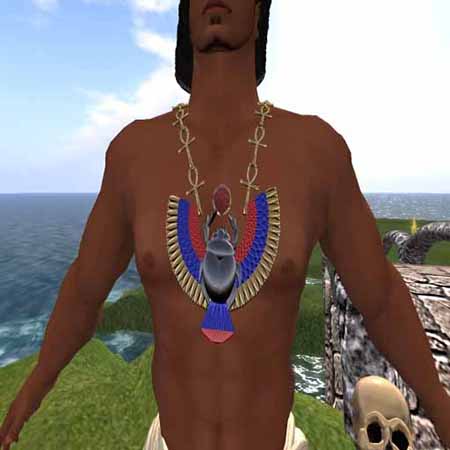
The ancient Egyptians had many amulets for different occasions and needs, often with the figure of a god or the "ankh" (the key of eternal life); the figure of the scarab god Khepri became a common amulet too and has now gained renewed fame around the Western world.
The use of amulets (meket) was widespread among both living and dead ancient Egyptians. They were used for protection and as a means of "... reaffirming the fundamental fairness of the universe".
The oldest amulets found are from the predynastic Badarian Period, and they persisted all the way through to Roman times.
Pregnant women would wear amulets depicting Taweret, the goddess of childbirth, to protect against miscarriage. The god Bes, who had the head of a lion and the body of a dwarf, was believed to be the protector of children. The god Bes, who had the head of a lion and the body of a dwarf, was believed to be the protector of children. After giving birth, a mother would remove her Taweret amulet and put on a new amulet representing Bes.
Amulets depicted specific symbols, among the most common are the ankh and the Eye of Horus, which represented the new eye given to Horus by the god Thoth as a replacement for his old eye, which had been destroyed during a battle with Horus's uncle Seth. Amulets were often made to represent gods, animals or hieroglyphs.
For example, the common amulet shape the scarab beetle is the emblem of the god Khepri. The most common material for such amulets was a kind of ceramic known as Egyptian faience or tjehenet, but amulets were also made of stone, metal, bone, wood and gold. Phylacteries containing texts were another common form of amulet.
Like the Mesopotamians, the ancient Egyptians had no distinction between the categories magic and medicine. Indeed for them "...religion was a potent and legitimate tool for affecting magical cures". Each treatment was a complementary combination of practical medicine and magical spells. Magical spells against snakebite are the oldest magical remedies known from Egypt.
The Egyptians believed that diseases stemmed from both supernatural and natural causes. The symptoms of the disease determined which deity the doctor needed to invoke in order to cure it.
Doctors were extremely expensive, therefore, for most everyday purposes, the average Egyptian would have relied on individuals who were not professional doctors, but who possessed some form of medical training or knowledge. Among these individuals were folk healers and seers, who could set broken bones, aid mothers in giving birth, prescribe herbal remedies for common ailments, and interpret dreams. If a doctor or seer was unavailable, then everyday people would simply cast their spells on their own without assistance. It was likely commonplace for individuals to memorize spells and incantations for later use.
Archaeologists have discovered an extremely rare and unusual ancient stone amulet in Jerusalem that could change our understanding of reading and writing in antiquity NY Post - September 3, 2024

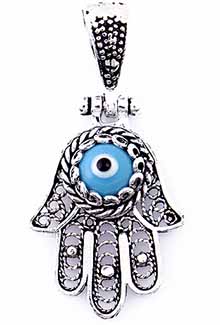
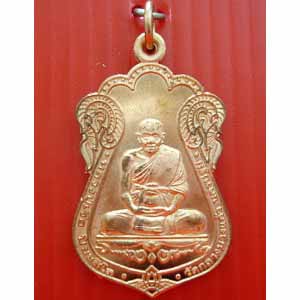
Some forms of Buddhism have a deep and ancient talismanic tradition. In the earliest days of Buddhism, just after the Buddha's death circa 485 B.C., amulets bearing the symbols of Buddhism were common. Symbols such as conch shells, the footprints of the Buddha, and others were commonly worn. After about the 2nd century B.C., Greeks began carving actual images of the Buddha. These were hungrily acquired by native Buddhists in India, and the tradition spread. In Thailand one can commonly see people with more than one Buddha hanging from their necks.
In certain areas of India, Nepal and Sri Lanka, it is traditionally believed that the jackal's horn can grant wishes and reappear to its owner at its own accord when lost. Some Sinhalese believe that the horn can grant the holder invulnerability in any lawsuit.
In the Philippines, the local amulet is called agimat or anting-anting. According to folklore, the most powerful anting-anting is the hiyas ng saging (directly translated as pearl or gem of the banana). The hiyas must come from a mature banana and only comes out during midnight. Before the person can fully possess this agimat, he must fight a supernatural creature called kapre. Only then will he be its true owner. During holy week, devotees travel to Mount Banahaw to recharge their amulets.
An ancient tradition in China involves capturing a cricket alive and keeping it in an osier box to attract good luck (this tradition extended to the Philippines). Chinese may also spread coins on the floor to attract money; rice also has a reputation as a carrier of good fortune.
In Bolivia and Argentina, the god Ekeko furnishes a standard amulet, to whom one should offer at least one banknote or a cigarette to obtain fortune and welfare.
In Afro-Caribbean syncretic religions like Voodoo, Umbanda, Quimbanda and Santeria, drawings are also used as amulets, such as with the veves of Voodoo; these religions also take into account the colour of the candles they light, because each color features a different effect of attraction or repulsion.
In Central Europe, people believed garlic kept vampires away, and so did a crucifix.
For the ancient Scandinavians, Anglo-Saxons and Germans and currently for some Neopagan believers the rune Eoh (yew) protects against evil and witchcraft; a non-alphabetical rune representing Thor's hammer still offers protection against thieves in some places.
Deriving from the ancient Celts, the clover, if it has four leaves, symbolizes good luck (not the Irish shamrock, which symbolizes the Christian Trinity). In the Celtic tradition a bag made from a crane skin (called a crane bag) symbolized treasure, a wheel symboled the sun, a boat also was a sun symbol, but also a death symbol (to the land of the dead), the raven was a symbol of death, the head was a symbol of wisdom as was the acorn and a well.
In antiquity and the Middle Ages, most Jews, Christians and Muslims in the Orient believed in the protective and healing power of amulets or blessed objects. Talismans used by these peoples can be broken down into three main categories. The first are the types carried or worn on the body.
The second version of a talisman is one which is hung upon or above the bed of an infirm person. The last classification of talisman is one with medicinal qualities. This latter category of item can be further divided into external and internal. In the former, one could, for example, place an amulet in a bath.
The power of the amulet would be understood to be transmitted to the water, and thus to the bather. In the latter, inscriptions would be written or inscribed onto food, which was then boiled. The resulting broth, when consumed, was assumed to transfer the healing qualities engraved on the food into the consumer.
Jews, Christians, and Muslims have also at times used their holy books in a talisman-like manner in grave situations. For example, a bed-ridden and seriously ill person would have a holy book placed under part of the bed or cushion.

Amulets are plentiful in the Jewish tradition, with examples of Solomon era amulets existing in many museums. Due to proscription of idols, Jewish amulets emphasize text and names - the shape, material or color of an amulet makes no difference.
The Jewish tallis (Yiddish-Hebrew form; plural is tallitot), the prayer shawl with fringed corners and knotted tassels at each corner, is perhaps one of the world's oldest and most used talismanic objects. Some believe it was intended to distinguish the Jews from pagans, as well as to remind them of God and Heaven. An incorrect conjugation of the plural form (with Ashkenazi pronunciation), "tallisim," is very close to the term "talisman;" however, this is an incorrect etymology as the word talisman is of Greek origin.
A little-known but well-worn amulet in the Jewish tradition is the kimiyah or "angel text". This consists of names of angels or Torah passages written on parchment squares by rabbinical scribes. The parchment is then placed in an ornate silver case and worn someplace on the body.
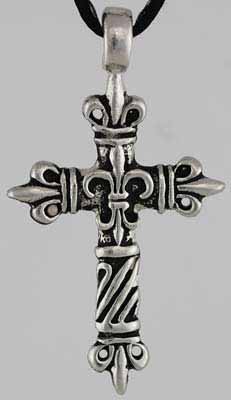
The Catholic Church, and Christian authorities in general, have always been wary of amulets and other talismans. However, the legitimate use of sacramentals, as long as one has the proper disposition, is encouraged in traditional Christianity. For example, the crucifix is considered a powerful apotropaic against demons and fallen spirits, and rosaries or St. Christopher medals are frequently hung on rear-view mirrors of vehicles in Christian cultures as a way of invoking God's protection during travel. Lay Catholics are not permitted to perform exorcisms but they can use Holy water, blessed salt and other sacramentals such as the Saint Benedict Medal or the Crucifix for warding off evil.
Crucifix
The Crucifix is one of the key Sacramentals used by Catholics and has been used to ward off evil for centuries. The imperial cross of Conrad II (1024-1039) referred to the power of the cross against evil. Many of the early theologians of the Catholic Church made reference to use of the sign of the Cross by Christians to bless and to ward off demonic influences. The crucifix is still widely used as an talismanic sacramental by Christians. In Christian culture, it is considered to be one of the most effective means of averting or opposing demons, as stated by many exorcists, including the famous exorcist of the Vatican, Father Gabriele Amorth.
A well-known amulet among Catholic Christians is the Saint Benedict Medal which includes the Vade Retro Satana formula to ward off Satan. This medal has been in use at least since the 18th century and in 1742 it received the approval of Pope Benedict XIV. It later became part of the Roman Catholic ritual.
Some Catholic Sacramentals are believed to defend against evil, by virtue of their association with a specific saint or archangel. The Scapular of St. Michael the Archangel is a Roman Catholic devotional scapular associated with Archangel Michael, the chief enemy of Satan. Pope Pius IX gave this scapular his blessing, but it was first formally approved under Pope Leo XIII. The form of this scapular is somewhat distinct, in that the two segments of cloth that constitute it have the form of a small shield; one is made of blue and the other of black cloth, and one of the bands likewise is blue and the other black. Both portions of the scapular bear the well-known representation of the Archangel St. Michael slaying the dragon and the inscription "Quis ut Deus?" meaning Who is like God?.
The Catechism of the Catholic Church (number 301) specifically refers to the use of Holy water for "protection from the powers of darkness". Catholic saints have written about the power of Holy water as a force that repels evil. Saint Teresa of Avila, a Doctor of the Church who reported visions of Jesus and Mary, was a strong believer in the power of Holy water and wrote that she used it with success to repel evil and temptations.
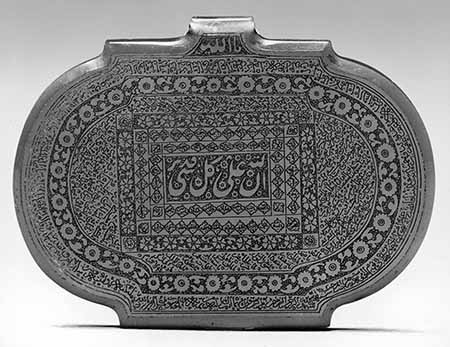
A talisman is any object that is imbued with protective powers, and all cultures have manifestations of such objects. In the world of Islam, they bear Qur'anic inscriptions as well as images of prophets, astrological signs, and religious narratives. Many Muslims believe that an object that is inscribed with the word God (Allah) will protect the person who reads, touches, or sees it and that the word of God has the power to ward off evil. The surface of a talismanic object can be covered with prayers, signs, numbers, and decorative motifs, and the object is carried in a pocket, or rolled and placed in an amulet case; some talismans are worn as clothing.
The most efficacious talismans are those that are inscribed with prayers that evoke the name of God and the Prophet Muhammad and his companions. The ninety-nine names of God, verses from the Qur'an, and sayings of the Prophet Muhammad (hadith), for example, are appropriated and regenerated into texts that are meant to be good omens.
Talismans that contain inscriptions with the names of prophets and religious figures have the power to protect an individual from hardship and danger by acting as conduits between these holy figures and anyone carrying the talisman. This is also true of devotional manuals by religious leaders (shaikhs) with passages stating that whoever reads them will be protected from demons and supernatural beings (jinn). The written story about a prophet can be protective as well, with pictorial representations of that prophet and of the omens associated with him.
The representations of certain prophets are more efficacious than others, with Solomon's as the most powerful of all. Solomon had the ability to talk to animals and supernatural beings (jinn), and was renowned for his wisdom; Bilqis, Queen of Sheba, was converted to monotheism by witnessing that wisdom.
The Qur'an states Solomon's authority in a number of verses (Qur'anic verse 27:17), and his apotropaic seal, a six-pointed star or hexagram, occurs on many surfaces, such as a wood panel, a blade, and a scroll.
Many other religious narratives also carry talismanic powers. The story of the miracle of the seven sleepers of Ephesus (ashab al-kahf, or "people of the cave"), which is the subject of a chapter in the Qur'an (Surat al-Kahf), has particular powers for many Muslims. The act of reciting the story of the seven Christian men and their dog Qitmir who, fleeing persecution by the emperor Decius (r. 249-51 A.D.), found a cave and slept for several hundred years, protects the reader from harm, just as the seven sleepers and their dog were protected all those years.
Images of the Prophet Muhammad's cousin cAli ibn Abi Talib and those of Imam cAli, son-in-law of the Prophet Muhammad, with his two martyred sons Hasan and Husayn, also carry apotropaic properties. Ali's miraculous sword (Dhu'l fiqar) becomes a relic and talismanic object in Islam, and is represented across various media.
Talismans not only shield but guide their wearers; they are objects that reflect occult practices. Amulet cases, mirrors, boxes, weapons, talismanic shirts, or banners are capable of shielding a person or group of people from the forces of evil. When a person is confronted with an ethical dilemma, all he needs to do is consult the Qur'an or one of these objects for guidance.
These imbued objects are also used as tools for scientists or as cures prescribed by physicians for various ailments. The cAbbasids (r. 750Ð1258) played an active role in the transmission of knowledge and science from the Greco-Roman world, and Arabic translations of medical and astrological texts were integral to Islamic court and daily life.
Historically, the stars and the Qur'an were consulted for almost every action and medical condition, and stars and talismanic objects became interconnected; and just as the stories of the prophets found in the Qur'an acted as talismans, the stars, too, would guide a person on his/her journey in this life and the afterlife. Eventually, elaborate horoscopes and a science of letters that broke down the ninety-nine names of God (ilm al-huruf) to their individual letters were created at court to predict whether a ruler was to have an auspicious reign. Sometimes these letters can be found on the clasp of a casket. The objects discussed here demonstrate the ways in which science, magic, and religious belief work together to endow objects with talismanic powers and protect individuals from harm.
Talismans that contain inscriptions with the names of prophets and religious heroes have the power to protect an individual from hardship and danger by acting as a conduit between the two. - Yasmine Al-Saleh - Harvard University
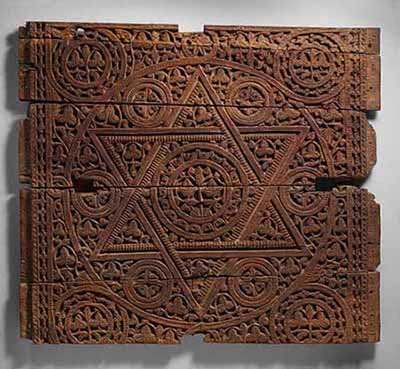
Talismans are not exclusive to portable objects. In the following example, the Seal of Solomon (a hexagram) is depicted on a carved teakwood panel from cAbbasid Iraq. Unfortunately, the actual architectural edifice it came from remains a mystery. Yet it evokes the ways in which talismans are used on architectural surfaces. Like objects, a talisman protects a city, mosque, palace, or any edifice from unknown harm, be it a scorpion, a snake, a supernatural being, or an enemy. In addition, the Seal of Solomon seen here, as well as images of animals such as lions, snakes, and scorpions, were commonly used to protect buildings and their inhabitants from harsh weather and evil spirits.

The swastika, one of the oldest and most widespread talismans known, can be traced to the Stone Age, and has been found incised on stone implements of this era. It can be found in all parts of the Old and New Worlds, and on the most prehistoric ruins and remnants. In spite of its antiquity, and the assertion by some writers that it was used by the Egyptians, there is little evidence to suggest they used it and it has not been found among their remains.
It is unknown whether the correct form stands with its arms turned to the left, or to the right. Both forms seem equally common, found both ways in various territories. On the stone walls of the Buddhist caves of India, which feature many of the symbols, arms are often turned both ways in the same inscription.
During the tumultuous Plains Indians troubles in mid-19th century America, the Lakota Tribe adopted the Ghost Dance ritual, created by a Paiute Indian living in northwestern Oregon. Black Elk, the great Lakota Holy Man, received instructions on how to create a talismanic shirt that would protect the Lakota from the Greedy White Man's bullets. Tragically, the shirts failed to offer the Lakota any protection.
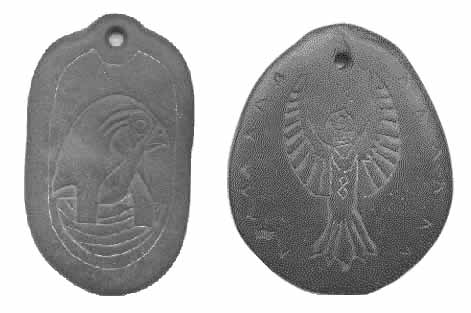
The two amulets above were found in an ancient burial tomb in close proximity to an ancient pyramid located in the Mississippi River Valley. The image on the left looks much like the Egyptian God Horus - resurrection and rebirth. The winged image on the right speaks of the alchemy of consciousness in "time" or "ascension".
According to legend, the amulets were found in the burial tomb of a High Priest and Priestess who inhabited that ancient city well over 30,000 years ago. They were laid to rest together so they might share the same union in the after world that they shared on the Earth plane. The strength of their union and concurrent time of death was indicated by the symbolic placement of their hands, one holding the other's.

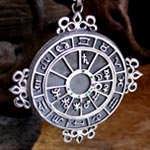 |
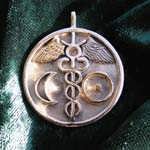 |
 |
| Personalized
Talisman |
Alchemical
Wedding Talisman |
Abundance
pendant |
Talismans and AmuletsBy the Artist - David Weitzman |
||